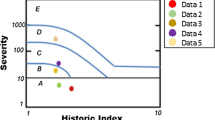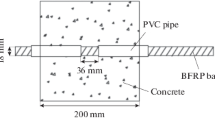Abstract
Most of the current researches on masonry damage assessment are qualitative rather than quantitative analysis. In this work, two acoustic emission (AE) rate process mathematical models were used to analyze the AE data during the in situ uniaxial compression test. The results showed that there was a linear correlation between AE cumulative events and the damage parameter, and the mathematical model proposed by S. T. Dai was suitable for analyzing the microcrack evolution of brick masonry material. Furthermore, the comparison of the fourth-order polynomial function and the Dai model with respect to the proportional coefficient k further demonstrated the applicability of the Dai model in damage assessment of in-service brick masonry structures.












Similar content being viewed by others
References
Livitsanos G, Shetty N, Hündgen D, Verstrynge E, Wevers M, Van Hemelrijck D, Aggelis DG (2018) Acoustic emission characteristics of fracture modes in masonry materials. Constr Build Mater 162:914–922
Han Q, Xu J, Carpinteri A, Lacidogna G (2015) Localization of acoustic emission sources in structural health monitoring of masonry bridge. Struct Control Health 22:314–329
Bassoli E, Vincenzi L, D’Altri AM, Miranda SD, Castellazzi G (2018) Ambient vibration-based finite element model updating of an earthquake-damaged masonry tower. Struct Control Health 25(5):e2150
Andreev K, Shetty N, Verstrynge E (2018) Acoustic emission based damage limits and their correlation with fatigue resistance of refractory masonry. Constr Build Mater 165:639–646
Bru D, Reynau R, Baeza FJ, Ivorra S (2018) Structural damage evaluation of industrial masonry chimneys. Mater Struct 51(1):34
Invernizzi S, Lacidogna G, Lozano-Ramírez NE, Carpinteri A (2019) Structural monitoring and assessment of an ancient masonry tower. Eng Fract Mech 210:429–443
Livitsanos G, Shetty N, Verstrynge E, Wevers M, Van Hemelrijck D, Aggelis DG (2019) Shear failure characterization in masonry components made with different mortars based on combined NDT methods. Constr Build Mater 220:690–700
Li SL, Wu YQ, Shi HS (2019) A novel acoustic emission monitoring method of cross-section precise localization of defects and wire breaking of parallel wire bundle. Struct Control Health 26:e2334
Ma YF, Li SL, Wu YQ, Wang DW, Liu MY (2019) Acoustic emission testing method for the sleeve grouting compactness of fabricated structure. Constr Build Mater 221:800–810
Li SL, Wu GM, Shi HS (2019) Acoustic emission characteristics of semi-rigid bases with three moisture conditions during bending tests. Road Mater Pavement 20:187–198
Li SL, Wu GM, Wu H (2016) Study on acoustic emission characteristics of a semirigid base of dense skeleton type during complete uniaxial compression tests. Adv Mater Sci Eng 2016:1–8
Geng JS, Sun Q, Zhang YC, Cao LW, Zhang WQ (2017) Studying the dynamic damage failure of concrete based on acoustic emission. Constr Build Mater 149:9–16
Rodríguez P, Celestino TB (2019) Application of acoustic emission monitoring and signal analysis to the qualitative and quantitative characterization of the fracturing process in rocks. Eng Fract Mech 210:54–69
Hu PY, Li SL, Jiang N, Yan YD (2019) Investigation of the impressed current cathodic protection method for the cable parallel wires in the rainwater electrolyte based on acoustic emission method. Constr Build Mater 229:116918
Wu YQ, Li SL, Wang DW (2019) Characteristic analysis of acoustic emission signals of masonry specimens under uniaxial compression test. Constr Build Mater 196:637–648
Antonaci P, Bocca P, Masera D (2012) Fatigue crack propagation monitoring by acoustic emission signal analysis. Eng Fract Mech 81:26–32
De Santis S, Tomor AK (2013) Laboratory and field studies on the use of acoustic emission for masonry bridges. Ndt&E Int 55:64–74
Vanniamparambil PA, Bolhassani M, Carmi R, Khan F, Bartoli I, Moon FL, Hamid A, Kontsos A (2014) A data fusion approach for progressive damage quantification in reinforced concrete masonry walls. Smart Mater Struct 23:15007–15017
Shetty N, Livitsanos G, Van Roy N, Aggelis DG, Van Hemelrijck D, Wevers M, Verstrynge E (2019) Quantification of progressive structural integrity loss in masonry with acoustic emission-based damage classification. Constr Build Mater 194:192–204
Tomor A, Verstrynge E (2013) A joint fatigue-creep deterioration model for masonry with acoustic emission based damage assessment. Constr Build Mater 43:575–588
Verstrynge E, Schueremans L, Van Gemert D (2010) Predicting the time to failure in heavily loaded masonry specimens with the acoustic emission technique. Adv Mater Res 133–134:217–222
Verstrynge E, Schueremans L, Van Gemert D, Wevers M (2009) Monitoring and predicting masonry’s creep failure with the acoustic emission technique. Ndt&E Int 42:518–523
Ortiz M (1988) Microcrack coalescence and macroscopic crack growth initiation in brittle solids. Int J Solids Struct 24:231–250
Ohtsu M (2015) Acoustic emission and related non-destructive evaluation techniques in the fracture mechanics of concrete. Fundam Appl. https://doi.org/10.1016/b978-1-78242-327-0.18001-8
Wang Y, Hu H, Lu G, Chen S, Liu S, Wang Y (2016) Effects of specimen height on the acoustic emission rate value ‘a’ for cement mortar. J Wuhan Univ Technol Mater Sci Ed 31:843–850
Su HZ, Tong JJ, Hu J, Wen ZP (2013) Experimental study on AE behavior of hydraulic concrete under compression. Meccanica 48:427–439
Ohtsu M, Watanabe H (2001) Quantitative damage estimation of concrete by acoustic emission. Constr Build Mater 15:217–224
Ohtsu M, Ichinose M, Watanabe H (2003) Damage estimation of concrete by AE rate process analysis. J Acoust Emiss 20:1–15
Ohtsu M, Suzuki T (2004) Quantitative damage evaluation of concrete core based on AE rate-process analysis. J Acoust Emiss 22:30–38
Alver N, Karcili M, Ercan E, Kauasaki Y, Ohtsu M (2014) Damage evaluation in concrete structures due to earthquake by AE rate-process analysis. In: Proceedings of 31st conference on European Working Group on AE, 9/3-5, Dresden
Wang Y, Hu HX, Wang N, Yan C, Chen SJ, Zhou L (2017) Experimental study of effects of water–cement ratio on the acoustic emission rate “a” values in concrete. Russ J Nondestruct 53:620–635
Dai ST, Labuz JF (1997) Damage and failure analysis of brittle materials by acoustic emission. J Mater Civ Eng 9:200–205
Karcili M, Alver N, Ohtsu M (2016) Application of AE rate-process analysis to damaged concrete structures due to earthquake. Mater Struct 49:2171–2178
Suzuki T, Ogata H, Takada R, Aoki M, Ohtsu M (2010) Use of acoustic emission and X-ray computed tomography for damage evaluation of freeze-thawed concrete. Constr Build Mater 24:2347–2352
Birgul R, Al-Shammari FMW, Yaman IO, Aktan MH (2004) Acoustic emission evaluation of concrete culverts. Res Nondestruct Eval 15:191–208
Ishibashi A, Matsuyama K, Alver N, Suzuki T, Ohtsu M (2016) Round-robin tests on damage evaluation of concrete based on the concept of acoustic emission rates. Mater Struct 49:2627–2635
Suzuki T, Ohtsu M (2014) Damage estimation of concrete canal due to earthquake effects by acoustic emission method. Constr Build Mater 67:186–191
Uranjek M, Bokan-Bosiljkov V (2015) Influence of freeze-thaw cycles on mechanical properties of historical brick masonry. Constr Build Mater 84:416–428
Suzuki T, Ohtsu M, Shigeishi M (2007) Relative damage evaluation of concrete in a road bridge by AE rate-process analysis. Mater Struct 40:221–227
Suzuki T, Ohtsu M (2004) Quantitative damage evaluation of structural concrete by a compression test based on AE rate process analysis. Constr Build Mater 18:197–202
GB 50292-2015 (2015) Standard for appraisal of reliability of civil buildings
GB/T 50315-2011 (2011) Technical standard for site testing of masonry engineering
Noorsuhada MN (2016) An overview on fatigue damage assessment of reinforced concrete structures with the aid of acoustic emission technique. Constr Build Mater 112:424–439
Melbourne C, Tomor AK (2006) Application of acoustic emission for masonry arch bridges. Strain 42:165–172
Feng L, Shu Lin L, Yun LX (2010) Relationship between acoustic emission parameter and mechanics parameters damage degree of concrete material. J Xiamen Univ 49:526–530
Wu YQ, Li SL, Wang DW, Zhao GH (2019) Damage monitoring of masonry structure under in situ uniaxial compression test using acoustic emission parameters. Constr Build Mater 215:812–822
Liu L, Zong ZH, Li MH (2018) Numerical study of damage modes and assessment of circular rc pier under noncontact explosions. J Bridge Eng 23:04018061. https://doi.org/10.1061/(asce)be.1943-5592.0001273
Mojškerc B, Kek T, Grum J (2019) Experimental characterization of quenching bath contamination using acoustic emission. J Nondestruct Eval 38(3):69. https://doi.org/10.1007/s10921-019-0608-3
Acknowledgements
The authors are grateful for the financial support from the National Natural Science Foundation of China (51778587, 51808510), Key Scientific and Technological Research Projects of Henan Province (192102310514), Supported by Foundation for University Young Key Teacher by Henan Province (2017GGJS005), Outstanding Young Talent Research Fund of Zhengzhou University (1421322059) and Science and technology planning project of Transportation in Henan Province (2016Y2-2, 2018J3).
Author information
Authors and Affiliations
Corresponding author
Ethics declarations
Conflict of interest
The authors declare that they have no conflict of interest.
Additional information
Publisher's Note
Springer Nature remains neutral with regard to jurisdictional claims in published maps and institutional affiliations.
Rights and permissions
About this article
Cite this article
Wu, Y., Gu, S., Zhao, G. et al. Damage assessment of the in-service brick masonry structure using acoustic emission technique. Mater Struct 53, 41 (2020). https://doi.org/10.1617/s11527-020-01475-y
Received:
Accepted:
Published:
DOI: https://doi.org/10.1617/s11527-020-01475-y




